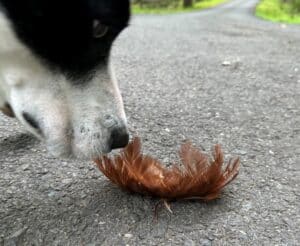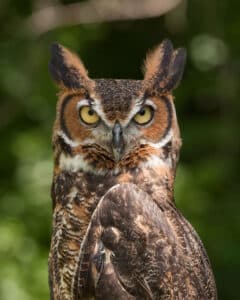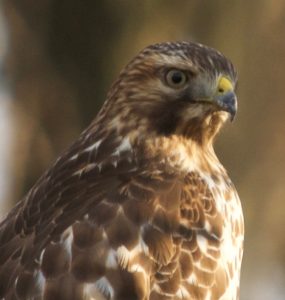Hello fellow readers,
Recently, while on the porch, I heard a plop in the pond and looked over to find the Red-shouldered Hawk flying out of it frog-less. He perched himself on the rail of our covered footbridge, looking quite regal – maybe he is she. I’ve learned they mate for life and nest in the same areas, although I’ve only seen one Red-shouldered Hawk at a time. They choose thick forests with wetlands and often go unseen. So how lucky I am to see them. And their young tend to live near where they are born.
Despite feeding on robin and blue jay nests in recent years, I’ve grown to admire my Red-shouldered resident and respect his role in the cycle of life. Though I can do without the ruckus of his early morning wake-up calls when camping on the screened porch with the loud, high-pitched “kee-aah” call to claim his territory and express alarm.

Jolee finds the remnants of a Red-shouldered Hawk.
Last week, on our way out for a morning walk, I saw what looked like clusters of rusty brown leaves in the middle of the private drive. As I approached, it turned out to be feathers attached to the tips of the wings—remnants of a Red-shouldered Hawk. Jolee sniffed the remains.
The Garden Benefits of Hawks and Owls
My heart felt heavy for the hawk, an interesting emotion given the sadness over losing baby birds and a prized bullfrog to the fellow. Plus, they benefit the garden by feeding on moles, voles, and chipmunks that can wreak havoc on plant roots.
Red-shouldered Hawks live all along the East Coast, into Southern Canada, and west into Texas and Mexico, with a few populations along the coast of California. They are year-round here, but many migrate to coastal areas in the fall and return in the spring. But according to the Conserve Wildlife Foundation of New Jersey, Red-shouldered Hawks (Buteo lineatus) are endangered with, what they believe, fewer than 200 pairs breeding. And it’s unknown if the number is increasing or decreasing.”
Solving the mystery of the feather remains.
Had the predator been a coyote, there wouldn’t be feather remains. While camping on the screen porch the night before, I heard a booming screech that woke me out of a deep sleep, and it occurred to me that perhaps the culprit was a Great-horned Owl.
Hawk Mountain.org added to my theory that in addition to the “reduced amount of habitat suitable for Red-shouldered Hawks,” the “loss of large forests also fostered more frequent competition with, and predation by, Great Horned Owls.”

Great-horned Owl By Greg Hume – Own work, CC BY-SA 3.0,
I often hear the series of deep four to five-hoots at night but have not seen him; Curt did one evening during the last call with Jolee. When I turned on the lights as he crossed the footbridge, he saw the grand owl take flight – about waist high, he thought. The shadows from the lights made the owl look larger than he is, though they can be up to about 25 in length with a 57-inch wingspan. The glow of his eyes was spectacular yet haunting.
Only when they’re young do Great-horned Owls have predators such as foxes and coyotes, so they are the king of the forest as birds go. Like hawks, the benefit of having owls is feasting on small rodents that impact our gardens. They also prey on larger mammals such as woodchucks, porcupines, skunks, and large birds such as geese, ducks, and hawks. Sadly they’ll snag a house cat or small dog too. While they usually hunt at night, they sometimes do by day.
Legends of Great-horned Owls & Red-shouldered Hawks
I did some digging about Great-horned Owl legends and myths ranging from when you see one, something terrible will happen. Perhaps someone will die. Or it’s a time of transition for you to make an essential decision in your life. Others say they symbolize wisdom, good luck, transformation, and filling one’s potential and desires.

Red-shouldered Hawk (Buteo lineatus)- Photo by Mike Niven
The Cherokee believed “Red-Tailed and Red Shoulder Hawks are messengers of vision. When you see one of these beautiful birds, whatever you were thinking about at the time is happening around you, or it will come true and manifest in your life.” So think good things; always a good thing.
Nature knows when there are enough of a species and has the master control over managing populations if we don’t intervene or disrupt the balance of things as we sadly tend to do. And so maybe Mother Nature needed to say goodbye to the Red-Shoulderd Hawk to give the frogs in our pond a chance to rejuvenate their population. It’s all part of the plan.
Garden Dilemmas? AskMaryStone@gmail.com and your favorite Podcast App.
There’s more to the story in the Garden Dilemmas Podcast:
Link to a previous column, Visions of the Red-shouldered Hawk
The Cornell Labs All About Birds link to The Great Horned Owl and Red-shouldered Hawk



I spotted and filmed (Snapchat) a Red Shouldered Hawk in December 23 in North Kent county, Rockford MI.
How cool! Thanks for sharing and for reading my blog.